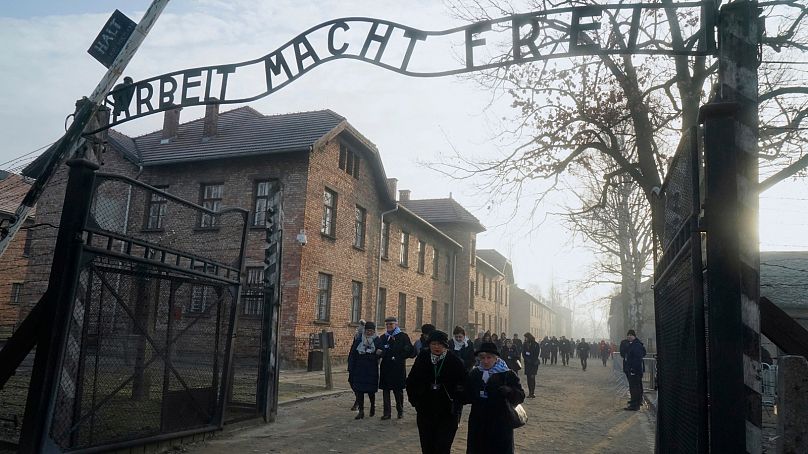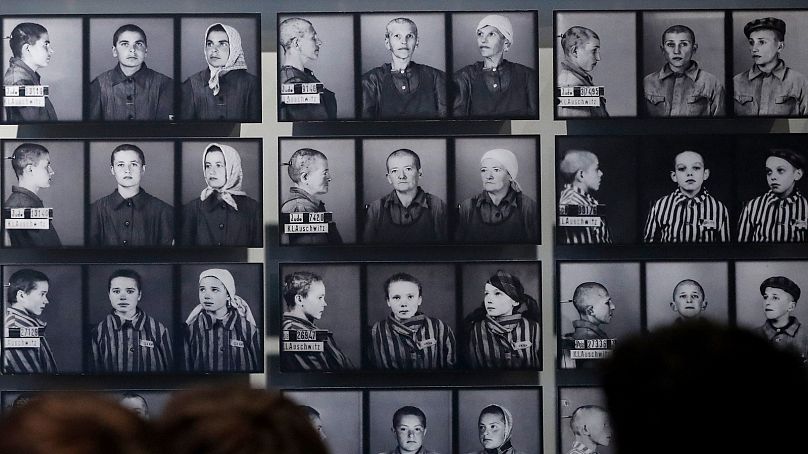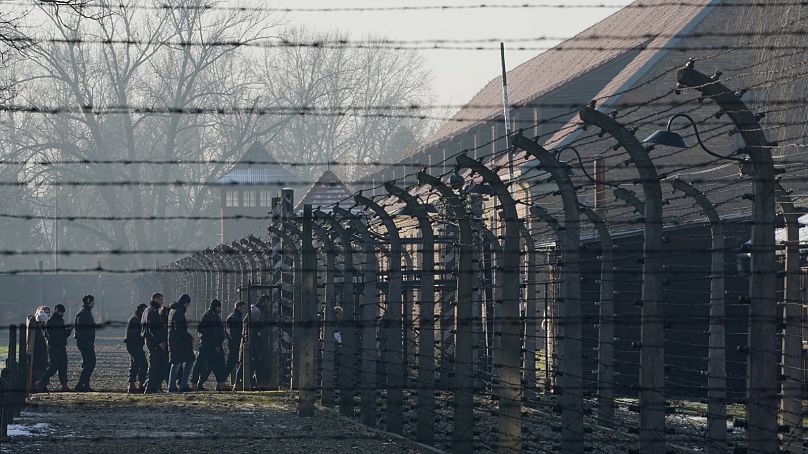Rudolf Vrba and Alfred Wetzler were the first Jews to escape from Auschwitz and warn the world of concentration camp genocide.
In April 1944, Rudolf Vrba and Alfred Wetzler became the first Jews to escape from Auschwitz.
Not only did the two Slovaks manage to flee the short distance across Poland to make it back to their homeland, their 32-page testimony of the barbarism they witnessed at the Nazi extermination camp, the so-called “Vrba-Wetzler report”, made clear to the world the true horror of the Holocaust.
That report was highly detailed, with the two young men able to draw maps of the camp, detailed diagrams showing where the barracks were location, where the gas chambers and crematoriums were. Vrba even committed to memory details of train arrivals, where they came from, and how many people were on board: crucial details which later helped the Allies understand the true extent of the Nazi genocide.
The lives of up to 200,000 Jews in Budapest were saved when their deportations were halted after the Vrba-Wetzler report came out, argued Jonathan Freedland, author of one of the most acclaimed nonfiction books of last year, "The Escape Artist: The Man Who Broke Out of Auschwitz to Warn the World", the story of Vrba and Wetzler retold for English speakers.
Their names deserve “to stand alongside Anne Frank, Oskar Schindler and Primo Levi, in the first rank of stories that define the Shoah,” Freedland said, though added: “That day may never come.”
When Wetzler died in Bratislava in 1988, he was “bitter, drunk and forgotten,” the Israeli author Ruth Linn wrote in a book about the pair. Vrba, who emigrated early from post-socialist Czechoslovakia, passed away in 2006 in Canada.
Slovakia’s foreign ministry notes on its website that their story “recently resurfaced” because in 2021 the well-known actor and producer Peter Bebjak directed a Slovak-language film “The Auschwitz Report” (titled locally as Zpráva) about the pair’s escape.
Many Slovaks on the streets of Bratislava will know they story of Vrba and Wetzler: "They are both well known in Slovakia, they are both part of the Slovak history class,” said Tomáš, a sales manager. "I remember their story from school,” Martin, another Bratislava resident, told Euronews.
However, neither Vrba nor Wetzler made it onto the shortlist of the "100 Greatest Slovaks" television programme organised a few years ago by the public-service broadcaster RTVS, a spin-off of the popular "Great Britons" TV series a decade earlier.
But RTVS came under criticism for showing Josef Tiso, Slovakia’s wartime fascist leader, on trailers for the show, suggesting he was a contender. There were even a suggestion Slovakia's National Criminal Agency might investigate the channel for instigating extremism.
The broadcaster eventually decided to exclude Tiso, a willing partner of Adolf Hitler. There were concerns viewers might have ranked him quite high.
A 2013 survey asked Slovaks how much they knew about what happened during the Holocaust. When asked how many people, mainly Jews, were deported from the Slovak lands during the Second World War, around half answered “I don't know”.
Estimates differ, but it's reckoned that around 58,000 Slovak Jews were deported to Nazi death camps.
Only a few hundred survived. The Slovak State, which broke away from Czechoslovakia in 1939, even paid the Nazis to help deport Jews, most to camps in neighbouring Poland. Slovaks were allowed to keep the property left behind.
“For many years, the topic of the Holocaust and the deportations of Jews from Slovakia during World War II were taboo,” Luciána Hoptová, of the University of Prešov, wrote in a 2020 academic essay about the teaching of the Holocaust in Slovakia’s schools.
Deborah L. Michaels, another academic who assessed Holocaust education in Slovakia, in 2015, argued that this was a spillover of sentiment in the 1990s.
After the fall of communism in 1989, she wrote, “the ideology of democratic liberalism encouraged a historical discourse that articulated minority rights.” Some historians began to tell the story of Slovakia’s role in the Holocaust, something hushed up under communist times.
In 1997, the European Union even came under flak after sponsoring the publication of a nationalist Slovak history textbook, approved by the country’s education ministry, that was conspicuously short on chapters about the Holocaust and Slovakia’s role in it.
This was around the time that US Secretary of State Madeleine Albright dubbed Slovakia “a black hole on the map of Europe.”
Things have markedly improved since, expert reckon. Now, the Holocaust “plays a very important role in the teaching of history,” Hoptová concluded in her 2020 essay.
Slovakia's first Holocaust Museum opened in 2016, in the southwestern city of Sereď. Study of the Holocaust is part of the national curriculum -- mandatory from the ninth grade onwards in state schools.
According to the curriculum’s unit on the Slovak State, the goal is for teachers “to specify gradual restrictions of the human rights and freedom of Jewish citizens.” The education ministry recommends students take trips to concentration camps and memorials, as Auschwitz is not too far across the Polish border.
“But the quality of that education depends on teachers,” Matej Beranek of the Holocaust Museum in Sereď told Euronews.
And it also depends on what children are taught at home.
According to a 2019 survey by Pew Research, Slovaks are amongst the least tolerant of minorities in Europe. Some 77% said they had negative opinions of Muslims, the highest of the European states surveyed; while 76% looked unfavorably upon the Roma -- only Italy recorded higher rates.
More striking, almost a third of Slovaks held unfavourable views of Jew; only Greeks were more intolerant.
The treatment of minorities came into sharp light last October when two men were shot dead outside a gay nightclub in Bratislava. The perpetrator, who committed suicide, left a note online describing the COVID-19 pandemic as a “Jewish plot to train the white race to be obedient”.
Zuzana Čaputová, the popular and liberal Slovak president, said afterwards that hatred of minorities had been fuelled by "stupid and irresponsible statements of politicians.”
Several political parties still continue to laud the Nazi-aligned Slovak State. Perhaps most infamous is Marian Kotleba, the figurehead behind a political party now known as the Kotlebists–People's Party Our Slovakia.
Many analysts and newspapers deem Kotleba to be openly “neo-Nazi”. Its symbols and outfits resemble the wartime Nazi puppet state’s Hlinka Guard, Tiso’s shock troops. Kotleba’s party rails mainly against “Gypsy criminals” but anti-semitism also features.
“We are Slovaks, not Jews, and that is why we are not interested in the Jewish issue,” Kotleba said in 2009, when asked by a local journalist about Slovakia’s wartime collaboration with the Nazis.
The party now controls 17 of the parliament’s 150 seats, having won around 8% of the popular vote at the last general election. Kotleba was governor of Banská Bystrica, the country’s largest region, and he finished fourth at the last presidential election, with around a tenth of the vote.
But his political fortunes are waning. Several other hard-right or far-right parties are stealing supporters; his party is dwindling in the latest opinion polls.
Last April, the Supreme Court gave him a six month suspended prison sentence for demonstrating sympathy for a movement directed at suppression of fundamental rights and freedoms, after he donated money to organisers of an event celebrating the formation of the Nazi-aligned Slovak State.
“On the one hand, we have those kinds of parties in the Slovak parliament,” Beranek, of the Holocaust Museum, said. “On the other hand, we have remembrance days.”
In September 2021, Eduard Heger, the prime minister, formally apologised for the so-called Jewish Code, a law enacted in 1941 by the Slovak State that placed oppressive restrictions on Slovakia’s Jews.
Slovakia has its own remembrance day each 9 September, the day in 1941 that the “Jewish Code” was proclaimed.
In March 2022, on the 80th anniversary of the first transport of Slovak Jews to Auschwitz, Slovakia’s parliament issued a resolution condemning the mass deportations. Kotleba’s party abstained.














